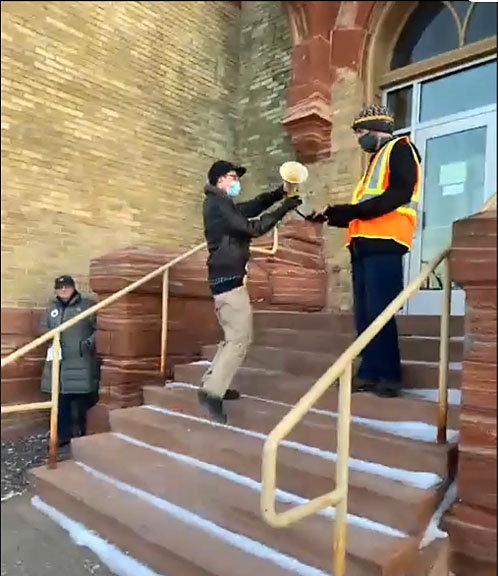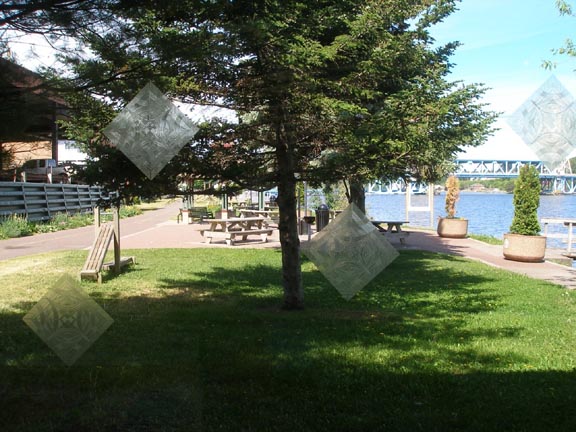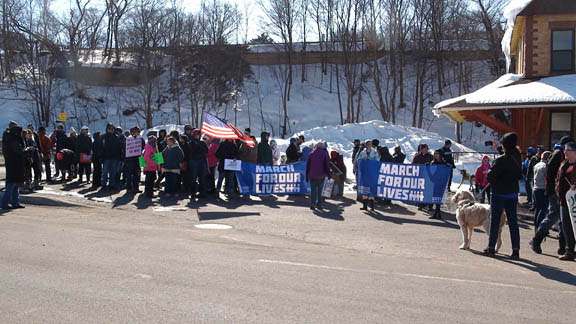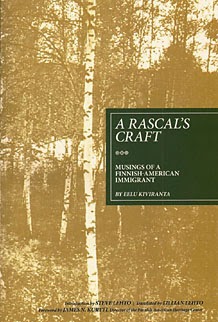By Michele Bourdieu
A crowd of about 400 filled the Ontario, Michigan and Huron rooms in Northern Michigan University's Don H. Bottum University Center on Aug. 28, 2012, for the Environmental Protection Agency's Public Hearing on the proposed County Road 595. EPA has made objections to the wetland and stream crossing impacts in the permit application. (Photos by Keweenaw Now)
MARQUETTE -- It was standing room only in Northern Michigan University's Great Lakes rooms for the Public Hearing on County Road 595 held on Aug. 28, 2012, by the Environmental Protection Agency (EPA).
The purpose of the hearing was to take comments from the public on the EPA's objections to the Marquette County Road Commission's application for a permit to fill wetlands and construct stream crossings for the proposed CR 595, a 21-mile public road from Rio Tinto-Kennecott's Eagle Mine on CR Triple A to the Humboldt Mill near US 41.
Although the permitting authority is presently the Michigan Department of Environmental Quality (MDEQ), the EPA acts as overseer to be sure the permit application is in accordance with federal requirements under §404 Guidelines of the Clean Water Act (CWA). In a letter last April, the EPA sent the MDEQ combined comments from three federal agencies -- the EPA, the US Fish and Wildlife Service and the Army Corps of Engineers -- objecting that the permit application for CR 595 does not follow CWA 404 Guidelines because "the project would lead to the significant degradation of aquatic resources, and the proposed wetland and stream mitigation would not fully compensate for the loss of aquatic function and value."*
During the informal question session from 6 p.m. to 7 p.m. that preceded the formal hearing, staff from EPA's Region 5 in Chicago and from the Michigan Department of Environmental Quality (MDEQ) gave a brief informational presentation, noting the EPA's objections and preferred alternative routes -- and then fielded questions from the audience.
EPA presents objections to proposed CR 595
Peter Swenson, EPA Region 5 (Chicago) Water Resources Division, Watersheds and Wetlands Branch chief, presented the EPA's objections and noted public comments would help the EPA determine whether to reaffirm, modify or remove its objection.
Under the CWA 404 Guidelines, the applicant (Marquette County Road Commission) has the responsibility to take necessary steps to avoid and minimize impacts to waters of the United States and must provide mitigation for any unavoidable impacts, Swenson explained.
The EPA also finds that alternative routes exist that would have fewer impacts to aquatic resources.
He displayed this map showing the Road Commission's preferred route, CR 595, and two alternative routes preferred by the EPA -- Mulligan Plains East/Sleepy Hollow and Red Road/Sleepy Hollow:
This map shows the Marquette County Road Commission's proposed CR 595 (green route) and two alternative routes preferred by the EPA -- Mulligan Plains East/Sleepy Hollow (brown route) and Red Road/Sleepy Hollow (red route).
Swenson also summarized the agency roles under the CWA with this slide:
This summary of the state and federal agency roles under the Clean Water Act applies to Michigan, one of two states (New Jersey is the other) in which CWA permitting authority is relegated to the state unless EPA objections are not resolved within a designated timeline. If, after the comment period on this application, EPA retains or modifies objections, MDEQ and the applicant will have 30 days to resolve them. If they do not, the Army Corps of Engineers will become the permitting authority.
Swenson pointed out reasons for concerns about wetlands, noting their functions include improving water quality, providing for floodwater storage, providing fish and wildlife habitat and representing a productive environment biologically.
"It's also important to note that Michigan has lost over half of its wetlands historically," Swenson said.
Most of the wetlands that would be impacted by the 595 route (75 percent of them) are high quality forested wetlands that are hard to replace, Swenson noted. He pointed out the important characteristics of northern forested wetlands with this slide:
One reason for the EPA's objection to the proposed CR 595 is that most of the wetlands it would impact are high quality forested wetlands, which are difficult or impossible to replace.
This chart gives a comparison of the wetland and stream impacts, as well as the costs, of the three roads:
In this chart, the figures for CR 595 have been updated from the original application. The Mulligan Plains East route would cost more than either of the other two routes because it would entail the construction of an expensive bridge.
Swenson also pointed out the differences in quality of wetlands in the EPA's recommended alternative routes:
In comparing the quality of wetlands potentially impacted by the three routes, the EPA concluded the Mulligan Plains East / Sleepy Hollow route would impact 35 percent less acreage of wetlands than CR 595 -- wetlands of similar quality. The Red Road /Sleepy Hollow route would have 25 percent less wetland impact than CR 595 while the impacted wetlands would be of lower quality than those potentially impacted by CR 595.
The federal agencies have also found the applicant's proposed mitigation for both wetlands and stream crossings to be insufficient. However, the Road Commission recently sent a revised mitigation plan, which the EPA and MDEQ are now studying, Swenson added.**
The EPA will prepare responses to the comments received by the deadline of Tuesday, Sept. 4, 2012. They will continue to review information provided by the applicant before making a decision. If EPA maintains its objection, the MDEQ would have 30 days to issue a permit that addresses EPA's concerns or to deny the permit. In that case the Army Corps of Engineers would become the permitting agency. Should EPA withdraw its objections, the MDEQ would issue the permit.
Questions from the public
After Swenson's presentation, members of the audience asked questions ranging from clarification of the choice of alternative routes to monitoring and enforcement to the stated purpose of the road and more.
In this video clip, questions pertain to mitigation, monitoring and enforcement, timeline for decision making, and CR 550 and 510 as alternatives. Members of the panel responding to questions include Tinka Hyde EPA Region 5 Water Division director; Peter Swenson, EPA Region 5 Water Division's Watersheds and Wetlands Branch chief and, seated at the table, from left, Melanie Haveman and Sue Elston, both of EPA Region 5 Water Division's Watersheds and Wetlands branch; Ginny Pennala, MDEQ Water Resources Division Upper Peninsula assistant district supervisor; and Steve Casey, MDEQ Water Resources Division Upper Peninsula district supervisor. (Video clips by Keweenaw Now)
More questions ...
In this video clip, questions include the timeline for the EPA decision, Humboldt Township's concern that CR FX is in a populated area, pollution other than wetland impacts, and clarification of permitting if EPA requires changes to address their objections.
Several questions from the audience concerned CR 550 and CR 510, which are presently being used by Rio Tinto-Kennecott, but have not been considered as alternative routes to the proposed CR 595 because the purpose of 595, as stated in the revised permit application (July 24, 2012) is the following:
"The purpose of the proposed CR 595 project is to construct a primary county north-south road that (1) connects and improves emergency, commercial and recreational access to a somewhat isolated but key industrial, commercial and recreational area in northwest Marquette County to US-41, and (2) reduces truck travel from this area through the County’s population centers."***
One question from the audience asks about the 510 alternative connecting CR 510 with US 41. See blue route on the map below:
This map, from p. 43 of the July 24, 2012, revised application for CR 595 shows several alternative routes considered for the road from the Eagle Mine on the AAA Road to the Humboldt Mill just off US 41 in Humboldt Township. The 510 alternative in blue avoids the city of Marquette, but still passes through populated areas, including Negaunee and Ishpeming. Click on map for larger version or go to the revised permit application, p. 43 of section 4.0 on the Alternatives Analysis. (Map courtesy Michigan Department of Environmental Quality Web site)***
In their questions, members of the audience express concerns about the reasons for the EPA's choice of alternative routes.
In the following video clip, Gabriel Caplett of Headwaters News asks why the EPA changed its objections from their previous objection to the Woodland Road proposal (in the same general vicinity, with similar wetland and stream impacts), in which Rio-Tinto-Kennecott was applying for a private road and EPA did not mention impacts to "population centers" as a concern.
Caplett says, "Rio Tinto or the Road Commission or whoever Rio Tinto uses to get the road pushed through can decide what their project purpose is in order to limit it to the exact geographical area where they want a project, so that really sort of restricts the EPA in what it can consider because it needs to basically consider what the applicant wants it to."****
Here Gabriel Caplett questions the project purpose as restricting the EPA. Others ask about the total number of wetlands in the area, and whether the applicant would have to submit a new application in order to substitute an alternative route.
Noting that the Army Corps of Engineers, in commenting on the Woodland Road project, found the stated purpose of that road deceptive, Catherine Parker of Marquette asked why the EPA has not considered comments by the Army Corps of Engineers to look at existing roads as a viable alternative.
A resident of Wright Street, making a statement rather than a question, added his concerns about additional traffic on Wright Street (where traffic is already heavy) should CR 595 not be approved and existing roads through the city of Marquette continue to be used.
EPA staff members' replies seemed to accept the project's stated purpose, in spite of the fact that it does not mention the road is intended to be a haul road for Rio Tinto-Kennecott -- a fact which is evident in the text of the application.
Final questions in this one-hour session preceding the hearing ask for further clarifications on whether existing roads could be an alternative. Another question concerns the permitting procedures should the EPA retain its objections.
The last day to provide written comments to EPA on their objections to this permit application for CR 595 is Tuesday, Sept. 4. Email comments to Melanie Haveman at rd.county@epa.gov.
Notes:
This is Part 1 of a two-article series on the Aug. 28, 2012, EPA Public Hearing. Watch for Part 2, on the formal hearing, coming soon.
* Click here to read the Apr. 23, 2012, letter from the EPA to the MDEQ.
** Click here for the (draft) revised wetland mitigation plan, dated Aug. 21, 2012.
*** Click here for the July 24, 2012, revised permit application.
**** Gabriel Caplett has written several articles on the CR 595 issue. Click here to read his May 6, 2012, article, "EPA Caving on Kennecott Road?" in Headwaters News.









































































































1 comment:
Here comes the usual comment, still valid, but, deplorably and disgracefully, still ignored by both sides of the discussions, now coming from the only experienced mining engineer speaking for the truth:
Without a doubt, and easily provable in a two-hour examination of the application for permits - the application document was unacceptable, sloppy, up to high-school standards, technically inadequate, not conforming to the Part 632 law requirements and - most significantly - deliberately fraudulent - to produce a mine plan
which, when corrected, predicts mine collapse.
These charges have not been contested but are simply glossed over. MDEQ, as the regulating agency, should have recognized these and many other shortcomings in the year 2006, but, for reasons not given, MDEQ overlooked them and granted the permits illegally.
Now, at this time, both sides of the controversy act as if the past wrongdoings are acceptable, thereby condoning them and promoting the criminal activities of Rio Tinto, Kennecott and MDEQ, as planned by Kennecott tacticians.
It is time to stop them and to revoke the permits, before they do more irreparable damage.
They seek huge profits for seven years - we must preserve the land essentially for ever, perhaps with responsible mining.
I am prepared to demonstrate th135e accuracy of my statements to the public. Kennecott is not.
Jack Parker, Mining Engineer
Toivola, MI 49963
Post a Comment